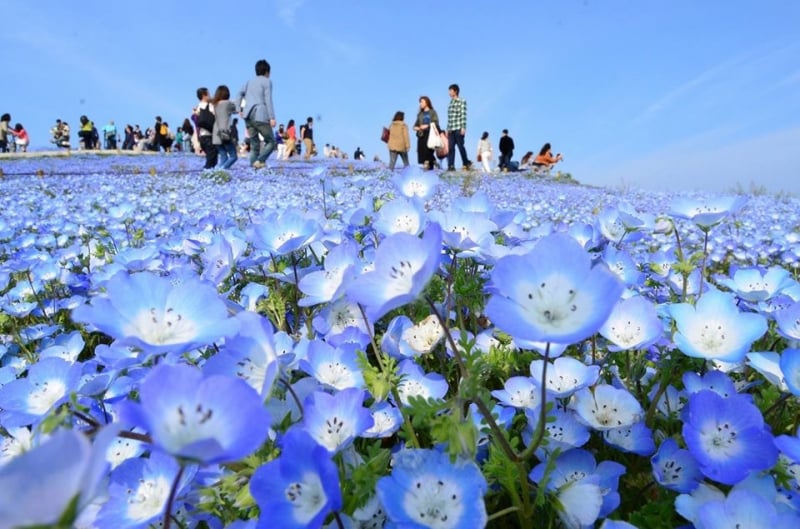
All about 5 Flower Parks to Visit in Kyushu Japan
Explore the Beauty of Kyushu: 5 Flower Parks You Must Visit When it comes to natural beauty and serene landscapes, Kyushu, Japan’s southwesternmost island, is a hidden gem waiting to be explored. Among its many attractions, the region boasts an array of stunning flower parks that are sure to leave you in awe. In this […]
Explore the Beauty of Kyushu: 5 Flower Parks You Must Visit
When it comes to natural beauty and serene landscapes, Kyushu, Japan’s southwesternmost island, is a hidden gem waiting to be explored. Among its many attractions, the region boasts an array of stunning flower parks that are sure to leave you in awe. In this article, we’ll take you on a virtual journey through five of the most captivating flower parks in Kyushu, Japan. From vibrant fields of blooming flowers to meticulously designed garden landscapes, Kyushu has something to offer every nature enthusiast and flower lover. So, let’s dive into the world of colors and fragrances that await you in Kyushu’s flower parks.
1. Kumamoto Suizenji Jojuen Garden

Located in the heart of Kumamoto City, Suizenji Jojuen Garden is a testament to Japanese precision and aesthetics. This beautifully landscaped garden is famous for its exquisite design, featuring miniature hills, a charming pond, and carefully pruned trees. While it may not be a traditional flower park, the garden bursts into color with seasonal blooms.
- Cherry Blossoms: In spring, the garden is a cherry blossom wonderland, with the delicate pink flowers creating a picturesque setting.
- Plum Blossoms: The plum grove is a sight to behold in late winter when thousands of plum blossoms bloom, filling the air with a sweet fragrance.
- Azaleas: During late spring, vibrant azalea bushes dot the garden, adding a burst of color to the landscape.
Don’t forget to take a leisurely stroll along the winding paths and enjoy the peaceful ambiance. Suizenji Jojuen Garden is a place where you can experience the harmony of nature and human craftsmanship.
2. Kawachi Fuji Garden
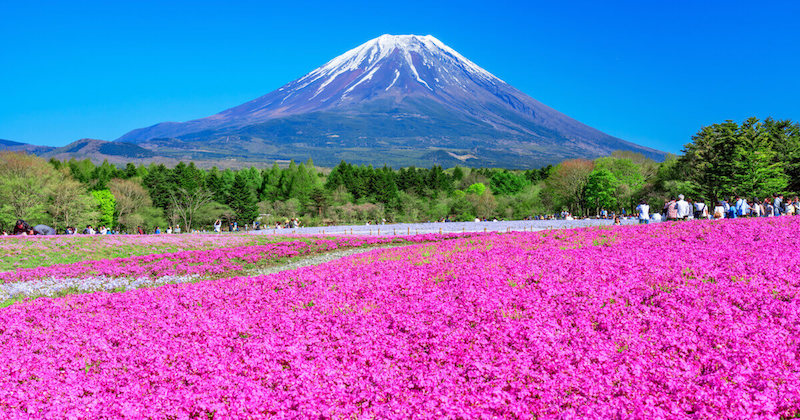
If you’ve ever dreamed of walking through tunnels of wisteria flowers, then Kawachi Fuji Garden is your dream come true. Located in Kitakyushu, this enchanting garden is world-renowned for its wisteria tunnels, which are in full bloom during late April to early May.
- Wisteria Tunnels: These tunnels are nothing short of a fairytale scene, with cascading wisteria flowers in shades of purple, pink, and white creating a magical canopy.
- Wisteria Trellis: The garden also features trellises laden with wisteria blossoms, forming a mesmerizing display of colors and fragrances.
Visiting Kawachi Fuji Garden during the wisteria season is like stepping into a fantasy world. The vibrant colors and fragrant blooms will leave you with memories to cherish.
3. Sakitsu Flower Park
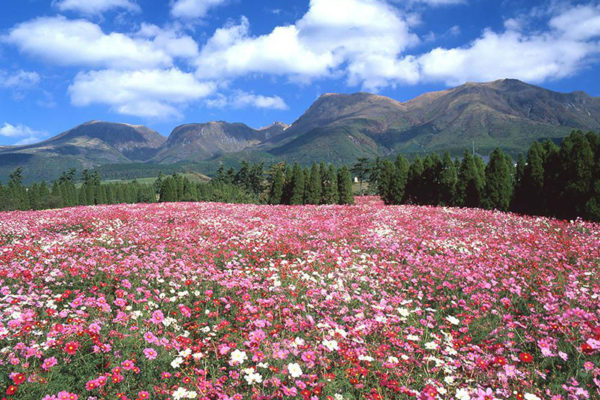
Sakitsu Flower Park, nestled in Amakusa, Kumamoto, is a delightful haven for flower enthusiasts. This park offers a unique blend of natural beauty and cultural heritage, making it a must-visit destination in Kyushu.
- Seasonal Flowers: Depending on the time of year, you can witness an array of flowers, including tulips, cosmos, and sunflowers, painting the park with their radiant colors.
- Historical Charm: What sets Sakitsu Flower Park apart is its location in a historic fishing village, adding a touch of nostalgia to your visit.
Take a leisurely stroll through the park’s well-maintained grounds and enjoy the serene atmosphere. It’s a perfect spot for both photography enthusiasts and those seeking a tranquil escape.
4. Kumamoto Prefectural Traditional Crafts Center Garden
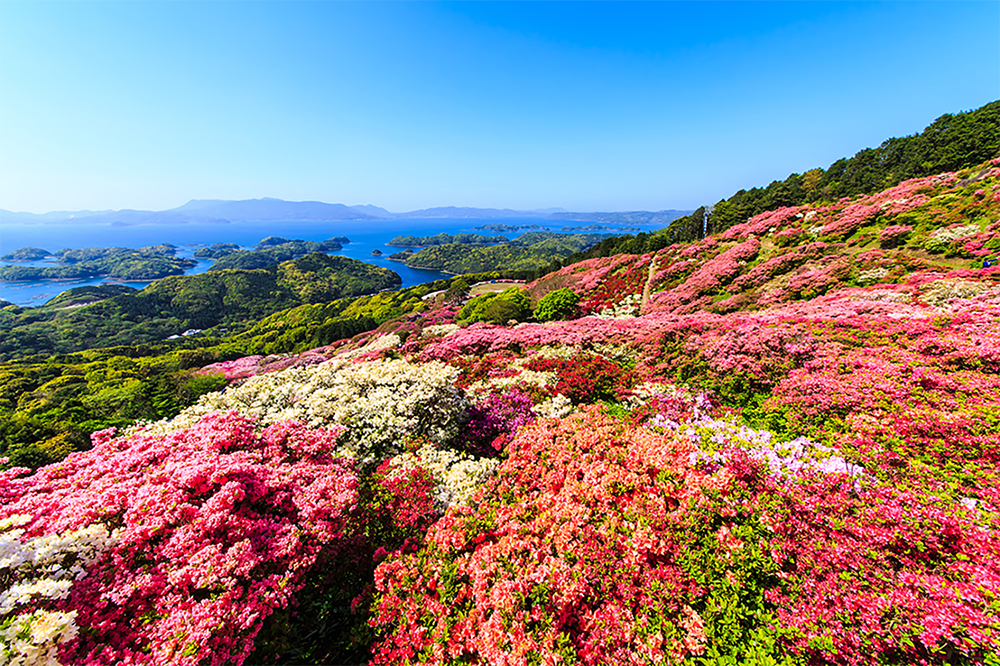
In Kumamoto City, the Kumamoto Prefectural Traditional Crafts Center Garden offers a unique experience that combines artistry with nature. This garden is an extension of the Crafts Center and is designed to showcase traditional Japanese crafts in a scenic setting.
- Bonsai Garden: One of the highlights of this garden is the impressive collection of bonsai trees. Admire the skill and patience that goes into crafting these miniature masterpieces.
- Seasonal Displays: Throughout the year, the garden is adorned with seasonal flowers and arrangements, making it an ever-changing landscape.
The Kumamoto Prefectural Traditional Crafts Center Garden is not just a feast for the eyes but also an opportunity to appreciate the artistry of Japanese craftsmanship.
5. Mifuneyama Rakuen
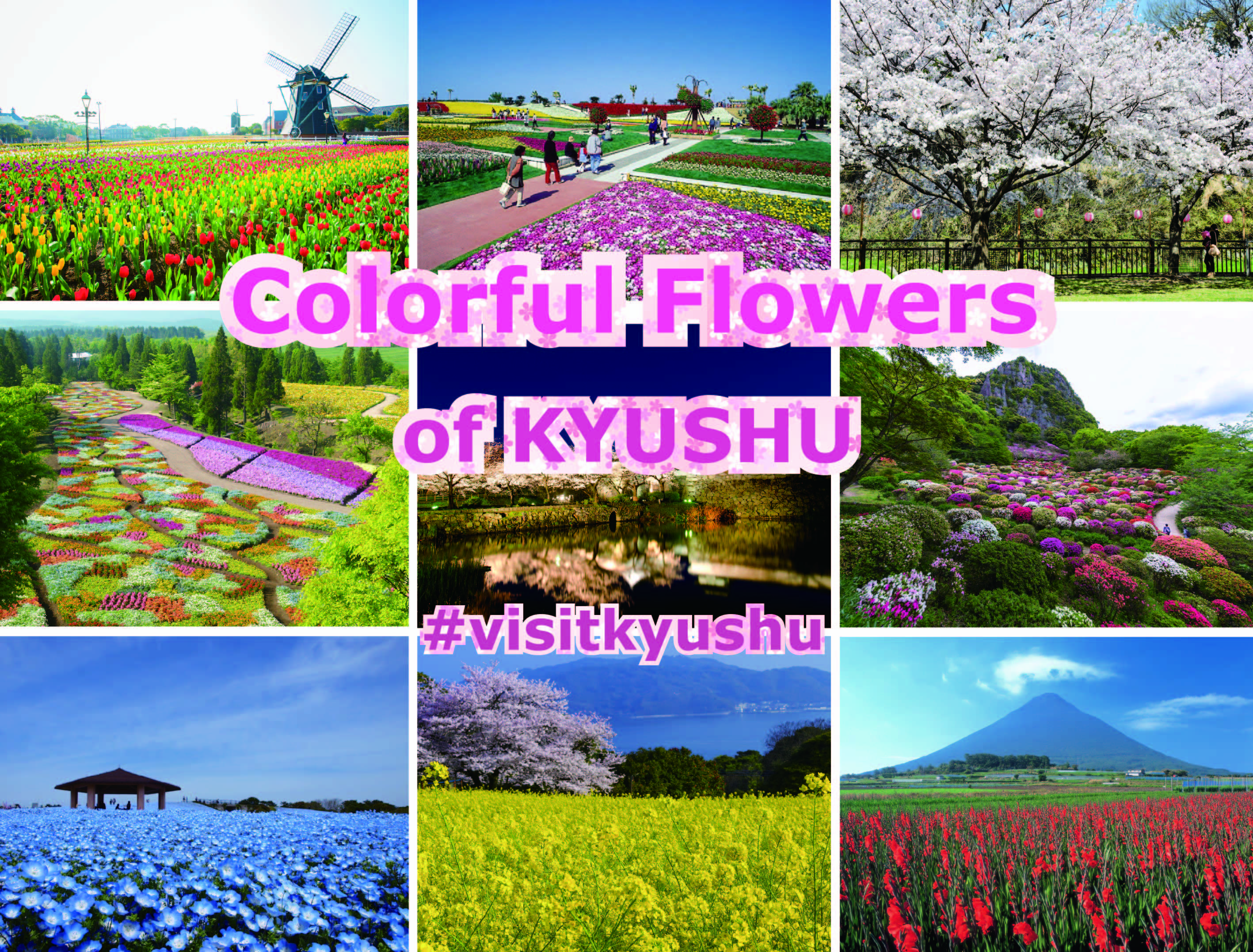
Nestled in Saga Prefecture, Mifuneyama Rakuen is a garden that seamlessly blends nature with contemporary art. It’s a place where the traditional and the avant-garde coexist in harmony.
- Rhododendron Garden: One of the highlights of Mifuneyama Rakuen is its expansive rhododendron garden, which comes alive with vibrant blooms in late spring.
- Art Installations: The garden features modern art installations scattered throughout, creating a unique juxtaposition of nature and human creativity.
Visiting Mifuneyama Rakuen is like stepping into a world where art and nature converge. The combination of meticulously maintained gardens and thought-provoking art makes it a truly captivating experience.
Plan Your Visit to Kyushu’s Flower Parks
Before you embark on your journey to explore these enchanting flower parks in Kyushu, Japan, here are a few practical tips to ensure a memorable experience:
- Seasonal Timing: Each park has its peak season when specific flowers are in full bloom. Plan your visit accordingly to witness the garden at its most vibrant.
- Photography: Don’t forget your camera! These parks offer countless opportunities for stunning photographs.
- Local Cuisine: While in Kyushu, be sure to savor the local cuisine. Kyushu is known for its delicious food, so don’t miss out on the culinary delights.
- Travel Responsibly: Respect the natural beauty of these parks by following all rules and guidelines. Help preserve the environment for future generations to enjoy.
Kyushu’s flower parks are not only a treat for the eyes but also a journey into the heart of Japanese culture and natural beauty. Whether you’re a nature lover, an art enthusiast, or simply looking for a peaceful retreat, these parks have something special to offer. So, pack your bags and immerse yourself in the colorful world of Kyushu’s flower parks.
FAQs
Q1: How can I get to Kyushu from Tokyo?
A1: You can reach Kyushu from Tokyo by taking a domestic flight to one of Kyushu’s major airports, such as Fukuoka Airport or Kumamoto Airport. Alternatively, you can take the Shinkansen (bullet train) from Tokyo to Hakata Station in Fukuoka, which offers a scenic journey through Japan.
Q2: When is the best time to visit Kyushu’s flower parks?
A2: The best time to visit depends on the specific park and the flowers you wish to see. Generally, spring and early summer are great for cherry blossoms and wisteria, while late spring to early summer is ideal for various other blooms.
Q3: Are these parks suitable for families with children?
A3: Yes, most of these parks are family-friendly and offer a peaceful environment for children to explore. However, be sure to supervise young children around delicate flowers and art installations.
Q4: Can I purchase souvenirs at these parks?
A4: Many of these parks have souvenir shops where you can purchase local crafts, gifts, and products related to the flowers and gardens. It
is a great opportunity to take home a piece of Kyushu’s charm as a memento of your visit.
Q5: Is there an entrance fee for these flower parks?
A5: Yes, there is usually an entrance fee for these parks, which helps with the maintenance and preservation of the beautiful landscapes. The fees are reasonable, and the experience is well worth it.
Q6: Are there guided tours available at these flower parks?
A6: Some parks offer guided tours, especially during peak seasons. It’s a great way to learn more about the park’s history, the significance of certain flowers, and the cultural aspects. Check with each park for tour availability.
Q7: Are there any local festivals or events held at these flower parks?
A7: Many of these parks host seasonal festivals and events. For example, during cherry blossom season, you might find hanami (flower viewing) picnics and traditional performances. Check the park’s website or local event listings for details on any upcoming festivities.
Q8: What is the weather like in Kyushu?
A8: Kyushu has a mild climate, making it pleasant to visit year-round. Summers can be hot and humid, while winters are mild, with occasional snow in some areas. Spring and autumn are generally considered the best times to visit due to the comfortable temperatures and beautiful blooms.
Q9: Can I take my pet to these flower parks?
A9: Most flower parks have restrictions on pets to protect the flora and fauna. It’s best to check with each park’s policies regarding pets before planning your visit.
Q10: Are there accommodations near these flower parks?
A10: Yes, you can find various accommodations near these flower parks, including hotels, ryokans (traditional Japanese inns), and guesthouses. It’s advisable to book your stay in advance, especially during peak seasons.
Conclusion: Embrace Nature’s Beauty in Kyushu
Kyushu’s flower parks offer a delightful escape into the world of vibrant colors, fragrant blooms, and artistic landscapes. Whether you’re drawn to the traditional elegance of Suizenji Jojuen Garden or the whimsical wisteria tunnels of Kawachi Fuji Garden, there’s something enchanting for every traveler.
As you plan your visit to Kyushu’s flower parks, remember to immerse yourself in the seasonal beauty, capture unforgettable memories through your lens, and savor the local flavors of this picturesque region. Kyushu’s flower parks are not just destinations; they are experiences that will stay with you long after your journey ends.
So, pack your bags, embrace the natural beauty, and let the allure of Kyushu’s flower parks captivate your senses. Your adventure in this enchanting corner of Japan awaits.
FAQs
Q1: How can I get to Kyushu from Tokyo?
A1: You can reach Kyushu from Tokyo by taking a domestic flight to one of Kyushu’s major airports, such as Fukuoka Airport or Kumamoto Airport. Alternatively, you can take the Shinkansen (bullet train) from Tokyo to Hakata Station in Fukuoka, which offers a scenic journey through Japan.
Q2: When is the best time to visit Kyushu’s flower parks?
A2: The best time to visit depends on the specific park and the flowers you wish to see. Generally, spring and early summer are great for cherry blossoms and wisteria, while late spring to early summer is ideal for various other blooms.
Q3: Are these parks suitable for families with children?
A3: Yes, most of these parks are family-friendly and offer a peaceful environment for children to explore. However, be sure to supervise young children around delicate flowers and art installations.
Q4: Can I purchase souvenirs at these parks?
A4: Many of these parks have souvenir shops where you can purchase local crafts, gifts, and products related to the flowers and gardens. It’s a great opportunity to take home a piece of Kyushu’s charm as a memento of your visit.
Q5: Is there an entrance fee for these flower parks?
A5: Yes, there is usually an entrance fee for these parks, which helps with the maintenance and preservation of the beautiful landscapes. The fees are reasonable, and the experience is well worth it.
Q6: Are there guided tours available at these flower parks?
A6: Some parks offer guided tours, especially during peak seasons. It’s a great way to learn more about the park’s history, the significance of certain flowers, and the cultural aspects. Check with each park for tour availability.
Q7: Are there any local festivals or events held at these flower parks?
A7: Many of these parks host seasonal festivals and events. For example, during cherry blossom season, you might find hanami (flower viewing) picnics and traditional performances. Check the park’s website or local event listings for details on any upcoming festivities.
Q8: What is the weather like in Kyushu?
A8: Kyushu has a mild climate, making it pleasant to visit year-round. Summers can be hot and humid, while winters are mild, with occasional snow in some areas. Spring and autumn are generally considered the best times to visit due to the comfortable temperatures and beautiful blooms.
Q9: Can I take my pet to these flower parks?
A9: Most flower parks have restrictions on pets to protect the flora and fauna. It’s best to check with each park’s policies regarding pets before planning your visit.
Q10: Are there accommodations near these flower parks?
A10: Yes, you can find various accommodations near these flower parks, including hotels, ryokans (traditional Japanese inns), and guesthouses. It’s advisable to book your stay in advance, especially during peak seasons.
key words
- going to japan 2024
- 1 round tokyo 2024
- all about living in japan
- what should do in japan in 1 week





